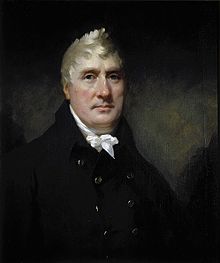John Rennie Sr.

John Rennie (born June 7, 1761 in East Linton , East Lothian , † October 4, 1821 in London ) was a Scottish civil engineer who designed numerous bridges, canals and docks.
Live and act
The son of a farmer has loved tinkering and building models since he was a child. He later became a carpenter specializing in mechanics and worked with Andrew Meikle , the inventor of the threshing machine . Rennie studied at the University of Edinburgh from 1780 to 1783 and then began to work as an engineer. He was hired by Boulton and Watt , James Watt's company , and built mills for five years. He was a pioneer in replacing wooden structures with iron.
In 1791 he moved to London and founded his own company there. His early projects include the Lancaster Canal (begun in 1792), the making the Chelmer and Blackwater Rivers navigable (1793), the Crinan Canal (1794), the Kennet and Avon Canal (begun in 1794) and the drainage of the Norfolk Fens ( 1802-1810). However, over the next few years he established himself as a renowned bridge builder. He combined stone with cast iron and created flat elliptical bridge arches that were previously unknown. Examples are the Leeds Bridge as well as the Waterloo Bridge (1810-1817) and the Southwark Bridge (1815-1819) in London.
In 1820 Rennie was appointed a foreign member of the Bavarian Academy of Sciences .
Rennie was also responsible for the design and construction of the docks in Kingston upon Hull , Liverpool , Greenock and Leith, as well as the expansion of the ports and shipyards in Portsmouth , Chatham and Devonport . His last project was the rebuilding of London Bridge , which began in 1821 and was completed by his son John Rennie junior . Rennie was buried in St Paul's Cathedral .
Web links
- Rennie, John (1761-1821) (DNB00) ; on the English Wikisource
Individual evidence
- ↑ Prof. Dr. John Rennie , members of the Bavarian Academy of Sciences
| personal data | |
|---|---|
| SURNAME | Rennie, John senior |
| ALTERNATIVE NAMES | Rennie, John |
| BRIEF DESCRIPTION | Scottish civil engineer |
| DATE OF BIRTH | June 7, 1761 |
| PLACE OF BIRTH | East Linton , East Lothian |
| DATE OF DEATH | October 4, 1821 |
| Place of death | London |